Home Access Control Systems
Home Access ControlSystems
In this chapter, you will learn about
- Access control devices and their applications
- Installing and wiring access control systems
Burglars and other intruders gain access to a home in a variety of ways. However, according to published statistics, 65 percent of them gain access to a home through one of a home’s doors. Only 6 percent of these uninvited evildoers gain access through an unlocked door, but more than 60 percent of illegal entries occur while a home is occupied. These statistics indicate that some type of access control system is needed to secure the doors of the average home to alert the homeowner or monitoring service of an entry attempt.
Access control systems include several features that are typically included in many residential security systems. However, home access security can be installed without the need for a whole-house security system. This chapter covers those devices and systems that can be installed solely to provide access control security to a home.
| CROSS-REFERENCE |
See Chapter 31 for more information about residential security system basics. |
Access Control Systems
A home access control system can be very simple and involve only such things as standard door locks. It can also be very complex and include the latest biometric devices straight out of the James Bond world. The level of complexity required for any home depends on two issues: the level of security required by the homeowners and their budget.
An access control system is any combination of devices that secure a home and prevent or detect an unauthorized entry through a door, window, or other exterior feature that can be used to gain access to a home. For the majority of homeowners, the access control system in use is limited only to a key-locking door handle and perhaps a deadbolt lock on the front and maybe the rear doors of the home. Often, sliding glass doors and the like are secured only with a toggle lock that is really not all that burglarproof. Adding additional access control security to any home can only make it safer.
Access Control System Components
Residential access control systems consist of a variety of devices that can be used to gain access to a secured home. The devices that are most commonly considered for a home’s access control system are
- Card readers
- Door locks
- Driveway loops
- Keypads
- Proximity card scanners
- Motorized gates
Card Reader Systems
Card reader systems scan coding on a credit card- or smaller-sized plastic or laminated card to unlock or open a door. While this technology is fairly commonplace in the business world, only a few types of card reader systems have been adapted for residential use. While newer card reader systems support the use of keychain cards in place of the credit card– sized cards, the plastic card is still the most common form of key card in use.
Most basic card readers only read a number from each card and transfer it to the card reader’s control unit or to the security system controller for processing by either the standard software or custom programming, respectively. More sophisticated systems offer the capability to create customized software, using C-language programming or a Windows- based interface on the card reader controller.
Depending on the type of card system in use, the need and the complexity of the actions that can be programmed into the system vary from very simple read-only features to Smart Card systems that can be used to activate a wide range of home security and automation actions. As the capabilities of the system increase, the level of programming required to customize the system also increases. Some manufacturers of the more sophisticated systems offer a variety of preprogrammed modules and templates that can be downloaded from the Internet or obtained on a disk as a means to simplifying this process.
The most common card reader systems used in residential applications are
- Barcode readers
- Magnetic stripe readers
- Proximity card readers
- Wiegand proximity card readers
Card Reader Wiring
Depending on the type of card the card reader is designed to scan, the wiring or connectors will vary. Card readers that are designed to interface with computer equipment directly will have either a 9-pin DB connector (DB-9) or an RF-45 plug. Some include a six or more position screw terminal strip to which the ground, power, and relay wires are connected. Powerline communications (PLC)-compatible card readers must be wired to a transformer that provides both the electrical power and the connection to the alternating current (AC) powerlines. Figure 36-1 illustrates the wiring required for a PLC card reader.
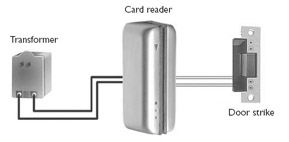
Figure 36-1: The wiring configuration of a PLC card reader connected to an electric door strike
Photo courtesy of Smarthome, Inc.
Barcode Readers
The technology of a barcode reader is quite similar to the readers used in the checkout stands at most supermarkets and chain stores. The primary difference between the home security barcode reader and the ones at the store is that in home systems, the barcode is swiped through a reader and not scanned.
The barcode encoded information, which is typically either a card number or a personal identification number (PIN), is printed on a plastic credit card sized card or on a paper card that has been laminated to prevent wear.
Actually, the reader reads the white (or dark gray) spaces of the barcode and not the black stripes (see Figure 36-2). The thickness of the white area represents a number or an alphabetic character that is then transmitted to a control unit and either verified (and the door is unlocked) or rejected. Some systems do include the capability to signal an erroneous read as well.

Figure 36-2: An example of barcode, similar to what is found on barcode reader access control system cards
Magnetic Stripe Readers
On the back of virtually all credit and automatic teller machine (ATM) cards is a black or reddish-brown stripe that is permanently magnetized with information, and in the case of home access security cards, it is a card number or PIN. When the card is passed through a magnetic stripe card reader, the reader picks up the electromagnetic fields of the stored information and translates it to digital data for processing.
There are two types of magnetic stripe cards: low coercivity and high coercivity. Low coercivity cards are easily damaged by a wide variety of magnetic sources, including other types of magnetic stripe cards that they may come into contact with in a wallet or purse. High coercivity cards are less easily damaged and are able to hold their information even when in contact with low-grade magnetic sources.
| Note |
Coercivity is the strength of a magnetic field required to reverse the polarity on a magnetic medium. |
High coercivity cards are more reliable because they are more resistant to common magnetic forces. However, the reliability of any magnetic stripe card depends on the magnetic film tape used on the card. The magnetic force that can erase a magnetic stripe card is coercive force, which is measured in Oersteds. A standard bankcard has a coercivity of around 300 Oersteds, which is low coercivity. At this level, a magnetic stripe card can be damaged by other cards in the same wallet or by the magnetic clasp on a purse. Card systems using magnetic materials with coercivity ratings of 2,100 to 4,000 Oersteds are less susceptible to being erased or damaged. When the card is swiped through the reader (see Figure 36-3), the magnetic stripe reader scans the magnetic stripe on the back of a card, translates the information, and then either transmits the information to a control unit that issues a signal to one of its relays or processes the information and sends a signal out one of its onboard relays. The relay where the approved signal is sent is attached to an electronic lock that releases and the door can then be opened. Unauthorized or damaged cards are rejected by a signal sent back to the card reader.
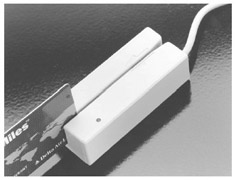
Figure 36-3: A magnetic stripe reader can be a stand-alone device like this one or built into another device.
Photo courtesy of Scan Technology, Inc.
Magnetic stripe readers are not a good option in areas where dust, dirt, heavy rains, or fog are a problem. Dust and moisture can cause the stripe reader to misread or fail altogether.
Proximity Card Readers
Unlike magnetic stripe card readers or barcode card readers, a proximity card reader doesn’t require a card to be inserted into the reader. When a proximity card is held near (in the proximity) the card reader, from two inches to six feet from the reader, the reader is able to detect the information on the card and capture it for processing.
Proximity cards and readers use low-frequency radio signals to communicate. A proximity card has a passive radio frequency (RF) transmitter embedded in it that continuously transmits its information. When the card is within range of the card reader, the information is received, processed, and verified, and signals are passed to the appropriate relay to open or unlock a door or gate. Passive devices do not require a battery to operate.
Many proximity card reader models also include a keypad like the one shown in Figure 36-4. On systems that require two levels of security, the keypad is used to enter a PIN after the card is scanned. On other systems, the keypad can be used in lieu of the card reader.

Figure 36-4: A proximity card reader with a keypad
Photo courtesy of HID Corp.
The primary benefit of a proximity card reader is convenience to the user. Another benefit is that they are also good for either indoor or outdoor use. The downside is that metal objects nearby can cause interference and the scanner in the reader can be damaged if the card is bent or flexed when it’s being scanned. However, the convenience of the system and its longevity—typically longer than contact readers like the magnetic stripe or barcode readers—outweighs the potential problems.
Wiegand Proximity Card Readers
Wiegand cards have special electromagnetic wires embedded in them in a specific pattern that is unique to each card. Like a standard proximity card reader, the cards and readers communicate using low-frequency radio waves. Because of this, they are virtually impossible to counterfeit. Another benefit to this type of card and reader is that they operate in extreme weather and environmental conditions, something not all other card reader types can do.
The Wiegand technology permits the “card” to be reduced to the size of a coin, key fob, small card, and other convenient sizes, like the keychain size shown in Figure 36-5.

Figure 36-5: A Wiegand keychain sized “pocket tag” proximity card
Photo courtesy of HID Corp.
| Note |
One more bit about access cards: every card, regardless of the type, is manufactured with a unique facility or site code. This code differentiates one user’s cards from another and prevents one user’s card from working with another user’s reader. |
Keypads
Keypad access control systems require a user to enter a multiple-digit code to gain access. Keypad units (see Figure 36-6) typically have a 10-digit number pad where the user can punch in her pass code.

Figure 36-6: A keypad access control unit
Photo courtesy of Kenny International.
Keypad systems are a good low-cost option in low-risk situations. This system is safe as long as the code stays secret. However, resetting the numerical code is simple using access directly on the keypad through an administrative number code.
Keypad Wiring
The wiring requirements for a keypad access control device depend on the devices the keypad will control, such as an electric door strike, or the other systems the keypad is to be connected to. If the keypad and a door strike are from the same manufacturer, it is likely that documentation details the wiring requirements of the two devices. However, if the keypad is to be used as a stand-alone key entry device that reports to a security system controller, the wiring, while fairly standard, may be a bit involved.
In every case, study the manufacturer’s documentation before beginning the installation of the keypad, which should normally happen during the trim-out phase. Some keypad devices may include a user interface connection on the internal circuit board that accepts a strip connector with up to 12 wire positions. Study the wiring diagrams if this is the wiring approach to be used to connect the keypad for remote trigger, panic, or other relay outputs or inputs.
On basic keypad devices, electrical wiring no larger than 16 AWG should be used to connect the keypad to its power source and a door strike, if used. Either unshielded twisted-pair (UTP) or shielded twisted-pair (STP) wiring is used to connect the keypad to the home security system controller for relay signals out or in.
Keypad Programming
Keypad systems can be programmed for several features, including settings that allow entry only during certain hours of the day, eliminating unauthorized access during set periods of the day or night. Programming a keypad system can be done a number of ways. The most common method to program the functions of a keypad system is to press the keys in certain sequences, according to the manufacturer’s documentation. Uploading a keypad’s program from the system controller or downloading the program from the system controller is another common way to program some keypads. In many cases, a computer-based programming interface is used to create keypad programming on the system control unit and then uploaded to each keypad.
Electronic Key Systems
An electronic key system (see Figure 36-7) works essentially like a regular lock and key. It has an electronic key that is inserted into a reader to either permit or deny access through a door. A reader can be set up to allow certain keys entry into some areas and other readers can be set up to not allow access to others.

Figure 36-7: An IR-remote control deadbolt
The advantage of an electronic key system is that a home’s locks don’t have to be rekeyed should a key be lost or stolen. Instead, the system can be easily reprogrammed to make the lost key inoperable.
Spare or new keys are typically assigned a pass-code number using a separate device called a key programming unit and the electronic cylinder or door lock unit can be programmed for additional key numbers or pass-codes using a lock programming unit that attaches to a personal computer. New programming is loaded to the cylinder unit through a special key attached to a cord on the lock programming unit.
Electric Door Lock Systems
Electric door lock systems are typically used in conjunction with an authorization device, such as a card reader, electronic key, or keypad. This type of access control device can be used to limit both entry and exit through a door. A card reader and other authorization systems send signals to an access control panel or directly to a connected device, such as an electric door lock. These signals, if received on the appropriate relay, instruct the lock to release the door.
Electric door locks consist of a number of components, including electric strike plates, magnetic locks, drop bolts, and electric locksets. However, not every door will work with an electric door lock and the door lock system needs to be fitted to the door, doorknob, and latch in each case.
A wide variety of products fall within the general category of electric locks, including remote control deadbolts, push-button and keypad door locks, and electric door strikes that can be used to upgrade an existing mechanical door lock.
Remote Control Deadbolts
A remote control deadbolt, see Figure 36-8, works essentially the same way a manually operated deadbolt does. The difference is that remote control deadbolts can be locked or unlocked using a multiple-function infrared (IR) remote control in addition to allow for manual operations.

Figure 36-8: An electronic key that is used with an electronic door lock system
Photo courtesy of Intellikey Corp.
Push-Button/Keypad Door Locks
Push-button and keypad door lock systems are keyless locks that can be unlocked by entering a code number sequence by pressing buttons or keys on the face of the door lock. As shown in Figure 36-9, the face of this type of lock system has a keypad. The keypad is used to both operate the door lock and enter programming commands.

Figure 36-9: A keypad deadbolt or door lock eliminates the need for a mechanical key.
Photo courtesy of Weiser Lock.
There are mechanical and electronic versions of this type of door lock system. A mechanical (nonelectric) push-button lock (see Figure 36-10) requires its buttons be pressed in a certain sequence.

Figure 36-10: A mechanical push-button door lock
One or more AA batteries are typically used to power an electronic keypad door lock. These devices, like the one shown in Figure 36-10, electrically retract the locking mechanism in the door latch when the correct sequence of keys is pressed. Programming, which typically means entering or changing the number set and sequence, is accomplished through the keypad.
Electric Door Strikes
Electric door strikes are available in a variety of styles to fit a variety of door materials and should be chosen based on the type of door in use. All electric door strikes, like the one shown in Figure 36-11, work essentially the same way: when an electrical charge is sent to the door strike, the locking mechanism releases to unlock the door. The door strike can be operated from a central security control unit acting on a command from a keypad to send a charge to the strike through a relay or a simple push-button release, like those used in many apartment houses and secured entries.

Figure 36-11: An electric door strike provides remote door lock control.
Photo courtesy of Rutherford Controls International Corp.
Several door lock system manufacturers also offer electric door strikes that are compatible with their standard door locks. Electric strikes operate on either 12- or 24-volt direct current (DC) or on AC power. Most electric strikes include a fail secure feature that keeps the door locked should the power source fail.
The installation of an electric door strike is performed much like the installation of a standard nonelectrical door strike in that the strike is installed into the door frame or on a wall in line with the door’s latching mechanism. The primary difference between an electrical strike and a nonelectrical strike is cabling.
The wire size installed to carry electrical signals to the strike varies by manufacturer, but one thing nearly all manufacturers agree upon is that the wiring must be plenum-rated. In most cases, the connector used is a two- or three-position snap-fit jack (see Figure 36-12) and plug that terminates the wiring of the strikes electronic module and the plenum cable, respectively.
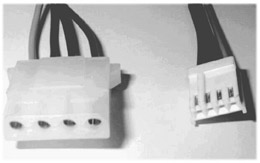
Figure 36-12: A wire-to-wire connector of the type commonly used with wiring for door strikes and other access control devices
Biometric Access Control Systems
Biometric access control systems use a feature of the users’ bodies to verify their identities, such as fingerprints, facial features, and even retinal patterns. For residential systems, the most commonly used biometric system is one that uses fingerprints to control access. These systems, like the one shown in Figure 36-13, typically have an IR finger well into which the user places her finger and the reader scans her fingerprint and matches the pattern entered during setup.
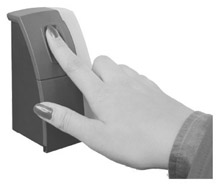
Figure 36-13: A fingerprint biometric access control system
Photo courtesy of Precise Biometrics.
The advantage of biometric access control systems should be obvious. There are no keys, cards, or codes to lose or forget. The homeowners carry their security devices with them at all times—right on the tips of their fingers, on their faces, or in their eyes.
The wiring required for a biometric access control system depends on the application. Biometric units produce a low-voltage charge to signal a pass condition, meaning the biometric scan produced a valid match. If the unit is to operate an electric door strike or other electric locking system, a relay module is required. However, if the signal is to be transmitted to a home security system controller, typically no additional modules are required for the biometric unit.
Wiring for biometric units can vary, but for the most part, four to six conductors of UTP wiring is required. Many units feature either RJ-45 or RJ-12 jacks for connecting to a network or a communications system. Electrical power is most commonly provided through a power-converting transformer plugged into an AC outlet near the device.
Programming a biometric unit, which is typically done through its keypad or interface, involves training the unit to record and recognize the hands, fingers, eyes, or other anatomical features of authorized users. Some additional programming may be required if the unit is to take more than a single output function. As the programming methods vary by model, follow the unit’s documentation for the programming process used.
Some high-end biometric units also record an exportable log file that can be accessed through a network or serial interface. The log file records all successful and, perhaps more importantly, unsuccessful attempts to gain access through the lock controlled by the unit. Whether or not the unit records a log file is a programming option.
Driveway Entry Detection Systems
If a home has a gated driveway, all of the access control systems discussed above can be used to control access through the gate. However, for homes without gated driveways but with a long driveway, the homeowners may wish to install a system that detects and reports a pedestrian, cyclist, or car entering the driveway. Driveway detectors can also be used to activate lighting systems along the driveway after dark. The signal from the driveway detector can be used to turn on entry and interior lighting.
There are a variety of driveway detection and monitoring systems available:
- Induction loop systems
- Metal detection systems
- Motion detection systems
Induction loop systems
This type of system is installed with loops of special cable placed under the driveway and uses a very similar technology to that used to detect cars on a street to trigger the traffic lights. As illustrated in Figure 36-14, the buried cable is induction cable that emits an electromagnetic field that has a fixed frequency. As a vehicle enters the induction cable’s field, the vehicle’s electromagnetic field interacts with that of the cable and changes the frequency of the inductive field. The control unit detects this frequency change and a relay is activated. Most driveway loop systems allow the sensitivity of the system to be set between high and low sensitivity, but it should not be set higher than necessary to detect vehicles entering the driveway so that vehicles passing by on the road do not trigger the control unit.
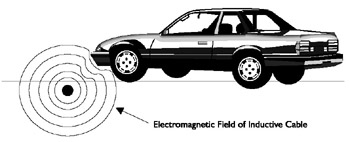
Figure 36-14: A car entering the electromagnetic field of a buried induction cable of a driveway loop system causes an alarm event.
Typically, the induction cable is installed under the concrete or paving material of a driveway in a rectangular or quadratic shape. Depending on the area and length of the driveway, multiple runs of the inductive cabling may need to be placed in the loop slot where the cable is laid. More cable is needed for smaller circumference loops than for larger loops. The cable should be laid far enough away from the street so it doesn’t false trip when a car on the road drives by the driveway.
Metal Detection systems
This type of system uses sensors that detect large metallic objects moving past, which can include steel-toed boots or other metallic objects such as an automobile that pass close to the sensor. These systems are typically installed as a wired system, with one or more sensors (see Figure 36-15) buried or placed on the ground’s surface along the side of the driveway, and then hardwired into a control unit that can then be connected to a home system. The control unit is then wired into the home system controller or home security system controller through its screw post connections, which are shown in Figure 36-15.
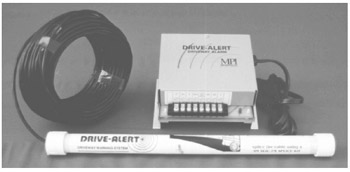
Figure 36-15: The sensor, cable, and controller of a driveway metal detection system
Photo courtesy of Mier Products, Inc.
Motion and Entrance Detection Systems
Exterior motion detectors and IR-beam detectors use passive infrared (PIR) to detect when an object enters a driveway or another exterior space. These systems are intended to provide a homeowner with early detection of an intruder.
Exterior Motion Detectors
Exterior motion detectors use the same basic technology as interior motion detectors. A PIR beam or sweep constantly scans a fixed area and signals a security event should the beam be interrupted. Some systems can be adjusted to detect only larger moving objects and can be configured with “pet alleys” to avoid signaling an alarm for pets and wild animals. Although several types of exterior motion detectors are available, many are wireless systems with ranges of up to 1,000 feet. Many exterior motion detector devices are incorporated into exterior security lighting fixtures, like the one illustrated in Figure 36-16.
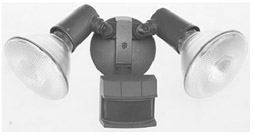
Figure 36-16: An exterior security lighting fixture with a built-in motion detector
Beam Entrance Detectors
A beam detector transmits a continuous IR beam, referred to as an IR laser beam in some models, between two stations, across a driveway, a garage entrance, a walkway, or whatever exterior feature the homeowner wishes to monitor. As illustrated in Figure 36-17, an IR beam detector requires two IR transceivers be placed in direct line of sight of each other across a monitored pathway or driveway. When an object, meaning a person, animal, or vehicle, breaks the IR beam, a signal is generated from the controlling transceiver. This signal travels to a controller device that then communicates it on to the subsystem control to which it’s connected.

Figure 36-17: An IR beam detects someone entering an area.
Each transceiver requires its own power source. Typically, transceivers are powered through a 12V DC current from an AC power transformer. One or both of the IR transceivers are wired into a device controller. The controller is then connected to a PLC control module or with UTP cable and either an RJ-12 or RJ-45 connector to the home control system.
Motorized Security Gates
In a home that is set back from a street and has a lengthy driveway, a barrier that prevents access to the driveway can provide both security and, in many cases, aesthetics as well. A remote control motorized security gate provides security by allowing only users with the proper remote access control device or keypad code open the gate for entry.
A motorized gate is equipped with a two-directional motor system that is used to open and close the gate upon receiving a signal. When the device controller receives a signal, it activates the gate motor, which performs the action opposite of the action last performed. What this means is that if the last action the gate performed was to open the gate, the next action will be to close the gate, much in the same way a garage door opener operates. Motorized gate systems are available as swing gate, slider gate, and lift gate systems.
Access through a motorized security gate is gained commonly through a remote control device, much like a garage door remote control, or through a keypad or card reader located on the side of the driveway. Although, the gate can be closed using a remote control or other access control device, including telephone-based systems, most systems can be configured to automatically close after a preset period of time, typically 30 to 60 seconds.
In a typical scenario, as a vehicle approaches the security gate, the driver uses an access control device to send a signal to the gate control device that activates the motor to open the gate. On a high-end system, inductor loops can be embedded under the driveway as outer and inner loops. As the vehicle moves through the gate, it passes from the outer loop to the inner loop, which creates a signal to keep the gate open. After both loops are cleared, a timer in the control unit controls when the motor is activated to close the gate. When a vehicle approaches the gate to exit the property, the inner loop signals the controller to open the gate and the gate is held open until the vehicle clears the outer loop.
Access Control System InstallationConsiderations
The primary installation issues for an access control system are wiring and the effective placement of the detection and control devices. The manufacturer’s recommendations for the type of wire to be used, placement of the sensors, inductive cables, and so on, should be followed to ensure an effective and functional installation.
Access Control Panels
The central point of most access control systems is a control panel. The reader, scanners, card slots, driveway systems, and other access control devices connect to the control panel as input devices and the door locks and door releases connect as output devices. In addition, the output can be wired as an input to a security system. Sometimes detection devices such as an exterior motion detector are wired directly to a security panel. The security system can sound an alarm or trigger an output such as notifying the lighting system to turn on the driveway and entry lights if it is dark.
In some preconfigured access control systems, the control panel (see Figure 36-18) performs the authentication process and in others, the control panel serves as a bridging device that redirects signals through relays to activate preset actions, such as through the lighting system, security system, door locks, and so on.
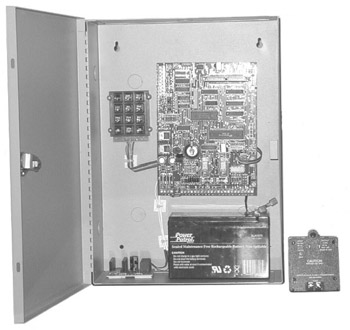
Figure 36-18: A security system control panel
Photo courtesy of Amtel Security Systems, Inc.
Access Control System Wiring
The most commonly recommended wiring standard for access control systems is RS-485, which requires 2 to 6 conductor 24 American Wire Gauge (AWG) twisted-pair cable. However, the cable properties specified in RS-485 are more than satisfied by Cat 5e cable.
When planning the structured wiring for a home that is to include an access control system, be sure to include homeruns of additional Cat 5e cabling to connect the system’s detection and locking devices to the access control panel and to the home control unit.
| Note |
Wiring for access control systems varies by manufacturer and, in some cases, even between models. Be sure to follow the manufacturer’s documentation and recommendations when wiring an access control device. Remember, no matter what, you should always follow the standard electrical and low-voltage wiring guidelines and codes applicable to a home’s location. |
Review
An access control system is any combination of devices that secure a home and prevent or detect an unauthorized entry through a door, window, or other exterior feature that can be used to gain access to a home.
Residential access control systems consist of a variety of devices used to gain access to a home, including card readers, door locks, driveway loops, keypads, proximity card scanners, and motorized gates.
Card reader systems read coding on a credit card- or smaller-sized plastic or laminated cards to unlock or open a door to a home. A basic card reader reads a number from the card and transfers it to a control unit or security system controller.
A barcode reader is similar to the devices used in the checkout stands at supermarkets. Barcode encoded information is printed on a plastic or paper card.
A magnetic stripe reader reads the information stored on a black or reddish-brown magnetic stripe placed on a plastic card. There are two types of magnetic stripe cards: low coercivity and high coercivity.
Proximity systems read information from a card held near the card reader using low-frequency radio signals. Wiegand cards are a type of proximity readers that have special electromagnetic wires embedded in them in a specific pattern, unique to each card.
Keypad access control systems require the entry of a multiple-digit code sequence.
An electronic key system works much like a regular lock and key, except that electronic keys are inserted into an electronic reader.
Electric door lock systems are typically used in conjunction with an authorization device, such as a card reader, electronic key, or keypad. This type of access control device can be used to limit both entry and exit through a door. A wide variety of products fall in the general category of electric locks, including remote control deadbolts, push-button and keypad door locks, and electric door strikes that can be used to upgrade existing mechanical door locks.
A remote control deadbolt works much like a manually operated deadbolt, except that a remote control deadbolt can be locked or unlocked through an IR remote control.
Push-button and keypad door lock systems are keyless locks that can be unlocked by entering a code number sequence by pressing buttons or keys on the face of the door lock.
Electric door strikes lock or unlock a door acting on a command from a charge sent to the strike through a relay or a simple push-button release.
Biometric access control systems use a feature of the users’ bodies to verify their identities, such as fingerprints, facial features, and even retinal patterns. For residential systems, the most commonly used biometric system is one that uses fingerprints to control access.
There are a variety of driveway detection and monitoring systems available: induction loop systems, metal detection systems, and motion detection systems.
An induction loop system installs loops of special cable under a driveway. The induction cable emits an electromagnetic field that interacts with anything that changes the frequency of the inductive field.
Metal detectors use sensors to detect large metallic objects moving past.
Exterior motion detectors emit a PIR beam or sweep that constantly scans a fixed area and signals a security event should the beam be interrupted. Beam detectors transmit a continuous IR beam between two stations and when an object breaks the IR beam, a signal is generated from the controlling transceiver.
A motorized gate is equipped with a two-directional motor system that is used to open and close the gate upon receiving a signal. Motorized gate systems are available as swing gate, slider gate, and lift gate systems.
The primary installation issues for an access control system are wiring and the effective placement of the detection and control devices. The manufacturer’s recommendations for the placement of the sensors, inductive cables, and so on, should be followed to ensure an effective and functional installation.
The central point of most access control systems is a control panel. The reader, scanners, card slots, driveway systems, and other access control devices connect to the control panel as input devices and the door locks and door releases connect as output devices.
The most commonly recommended wiring standard for an access control system is RS-485, which specifies 4 to 6 conductor 24 AWG twisted-pair cable. The cable properties specified for RS-485 cabling are more than satisfied by Cat 5e cable.
Questions
- Access control systems are used primarily for what purpose?
- Intrusion detection and alarm
- Remote monitoring services
- Preventing unauthorized entry
- Securing windows
- Which of the following is not typically part of a home’s access control system?
- Card reader
- Interior motion detector
- Electric door lock
- Keypad
- Which of the following types of readers do not require a card or key be inserted or swiped?
- Barcode
- Magnetic stripe
- Proximity cards
- Electronic key
- What type of card system uses embedded wires arranged in a unique pattern?
- Proximity
- Magnetic stripe
- Barcode
- Wiegand
- What technology is used with proximity card systems?
- Barcode
- Magnetic stripe
- RF
- IR
- What is the drawback to using keypad access control systems?
- Length of the numerical code
- Limited number of codes
- Unauthorized person learning code
- Weather
- Which of the following is the physical feature most commonly used for residential biometric access control systems?
- Facial features
- Fingerprint
- Retinal scan
- Ear scan
- What type of system uses cables installed under the driveway to detect a car entering the driveway?
- Induction loop systems
- Metal detection system
- Motion detection systems
- Visual detection systems
- What cable type can be used in place of the recommended RS-485 cabling for an access control system?
- Cat 3
- Cat 5e
- Coaxial cable
- Quad wire
- What device is used to bridge and control the sensors and detection systems
of an access control system to door locks and other entry security devices?- Bridge
- Central switch
- Control panel
- Hub
Answers
- C. Interior and exterior security systems incorporate the other choices, but an access control system is used to control the entry into a home.
- B. Access control systems are focused solely on alerting the homeowner to a visitor’s presence and the control of access to the home.
- C. These systems use RF signals that can be detected from a short distance of the reader. The other choices require a card or key be inserted or swiped through a reader.
- D. Because the pattern of wires in a card is essentially manufactured into the card, they are virtually impossible to counterfeit.
- C. Proximity cards use passive low-frequency radio frequency technology to communicate.
- C. As long as the code number to be entered on the keypad is secret, the system remains secure. None of the other choices are typically much of a problem.
- B. Although the other choices, well, perhaps with the exception of an ear scan, can be used, the equipment is prohibitively expensive for residential applications. As far as I know, there are no ear scan systems.
- A. As a car drives over the induction loop, the frequency of the electromagnetic field changes, which is detected by the system’s controller. The other choices listed are generally above-ground systems.
- B. Cat 5e wiring, which is typically used for structured wiring anyway, can be used to connect access control sensors and detection systems to the access control panel.
- C. In most access control systems, the microprocessor and processing capabilities exist in the control panel, which performs authentication and authorization functions.
Part I - Home Technology Installation Basics
- Wire and Cable Basics
- Connector Types and Uses
- Wiring Installation Practices
- Codes, Standards, and Safety Practices
Part II - Structured Wiring
- Infrastructure Wiring Basics
- Planning a Structured Wiring Installation
- Rough-In Installation
- Trim-Out Installation
- Troubleshooting Structured Wiring
Part III - Home Computer Networks
- Computer Network Basics
- Computer Network Hardware
- Computer Network Software
- Designing and Installing a Computer Network
- Troubleshooting a Home Network
Part IV - Audio/Video Systems
- Distributed Audio System Basics
- Designing and Installing Distributed Audio Systems
- Distributed Video Basics
- Designing and Installing Distributed Video Systems
- Troubleshooting Audio Systems
- Troubleshooting Video Systems
Part V. Home Lighting Management Systems
- Home Lighting Basics
- Home Lighting Devices
- Designing a Home Lighting Control System
- Installing a Home Lighting Control System
- Troubleshooting and Maintaining Lighting Control Systems
Part VI - Telecommunications
- Home Communication System Basics
- Designing and Installing a Home Telephone System
- Troubleshooting a Home Communication System
Part VII - HVAC and Water Management
Part VIII - Security System Basics
- Security System Basics
- Designing a Home Security System
- Installing a Home Security System
- Troubleshooting and Maintaining a Home Security System
- Home Security Surveillance Systems
- Home Access Control Systems
Part IX - Home Technology Integration
- Defining Users Needs and Desires
- User Interfaces
- Home Automation Controllers
- Programming
- Integrating the Connected Home
- Other Home Technology Integration Devices
Part X - Appendices
EAN: N/A
Pages: 300
- Key #1: Delight Your Customers with Speed and Quality
- Key #2: Improve Your Processes
- Key #4: Base Decisions on Data and Facts
- Making Improvements That Last: An Illustrated Guide to DMAIC and the Lean Six Sigma Toolkit
- The Experience of Making Improvements: What Its Like to Work on Lean Six Sigma Projects
